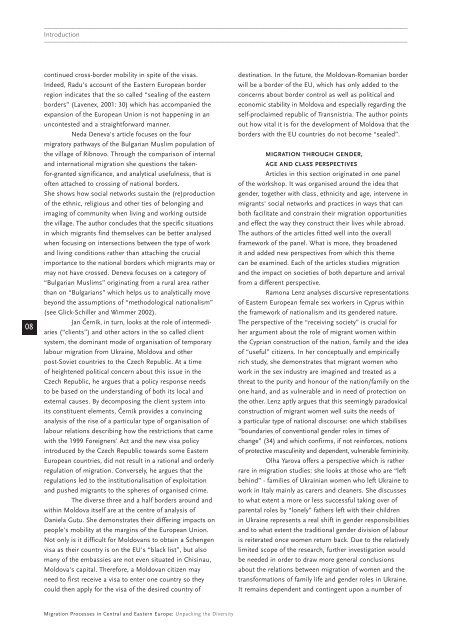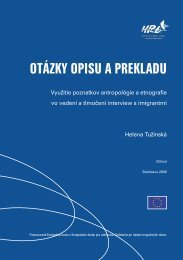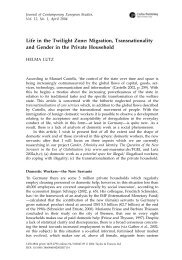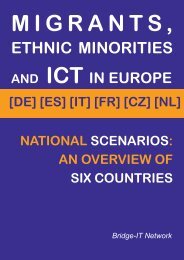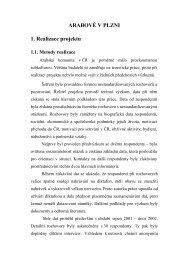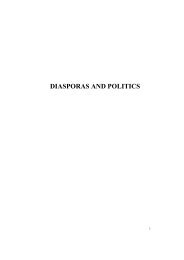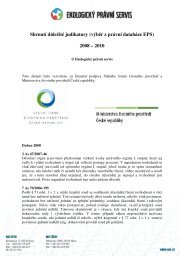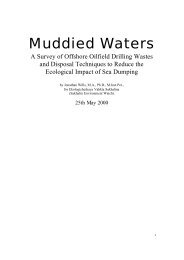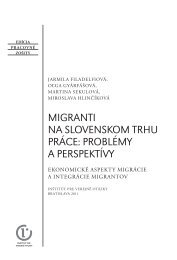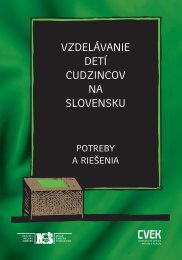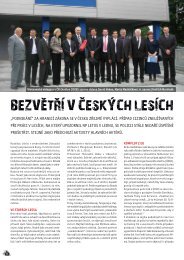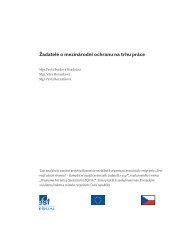Migration Processes in Central and Eastern Europe - Multiple Choices
Migration Processes in Central and Eastern Europe - Multiple Choices
Migration Processes in Central and Eastern Europe - Multiple Choices
You also want an ePaper? Increase the reach of your titles
YUMPU automatically turns print PDFs into web optimized ePapers that Google loves.
———————————————————————————————————————————————————————————————<br />
Introduction<br />
———————————————————————————————————————————————————————————————<br />
08<br />
cont<strong>in</strong>ued cross-border mobility <strong>in</strong> spite of the visas.<br />
Indeed, Radu's account of the <strong>Eastern</strong> <strong>Europe</strong>an border<br />
region <strong>in</strong>dicates that the so called “seal<strong>in</strong>g of the eastern<br />
borders” (Lavenex, 2001: 30) which has accompanied the<br />
expansion of the <strong>Europe</strong>an Union is not happen<strong>in</strong>g <strong>in</strong> an<br />
uncontested <strong>and</strong> a straightforward manner.<br />
Neda Deneva's article focuses on the four<br />
migratory pathways of the Bulgarian Muslim population of<br />
the village of Ribnovo. Through the comparison of <strong>in</strong>ternal<br />
<strong>and</strong> <strong>in</strong>ternational migration she questions the takenfor-granted<br />
significance, <strong>and</strong> analytical usefulness, that is<br />
often attached to cross<strong>in</strong>g of national borders.<br />
She shows how social networks susta<strong>in</strong> the (re)production<br />
of the ethnic, religious <strong>and</strong> other ties of belong<strong>in</strong>g <strong>and</strong><br />
imag<strong>in</strong>g of community when liv<strong>in</strong>g <strong>and</strong> work<strong>in</strong>g outside<br />
the village. The author concludes that the specific situations<br />
<strong>in</strong> which migrants f<strong>in</strong>d themselves can be better analysed<br />
when focus<strong>in</strong>g on <strong>in</strong>tersections between the type of work<br />
<strong>and</strong> liv<strong>in</strong>g conditions rather than attach<strong>in</strong>g the crucial<br />
importance to the national borders which migrants may or<br />
may not have crossed. Deneva focuses on a category of<br />
“Bulgarian Muslims” orig<strong>in</strong>at<strong>in</strong>g from a rural area rather<br />
than on “Bulgarians” which helps us to analytically move<br />
beyond the assumptions of “methodological nationalism”<br />
(see Glick-Schiller <strong>and</strong> Wimmer 2002).<br />
Jan Černík, <strong>in</strong> turn, looks at the role of <strong>in</strong>termediaries<br />
(“clients”) <strong>and</strong> other actors <strong>in</strong> the so called client<br />
system, the dom<strong>in</strong>ant mode of organisation of temporary<br />
labour migration from Ukra<strong>in</strong>e, Moldova <strong>and</strong> other<br />
post-Soviet countries to the Czech Republic. At a time<br />
of heightened political concern about this issue <strong>in</strong> the<br />
Czech Republic, he argues that a policy response needs<br />
to be based on the underst<strong>and</strong><strong>in</strong>g of both its local <strong>and</strong><br />
external causes. By decompos<strong>in</strong>g the client system <strong>in</strong>to<br />
its constituent elements, Černík provides a conv<strong>in</strong>c<strong>in</strong>g<br />
analysis of the rise of a particular type of organisation of<br />
labour relations describ<strong>in</strong>g how the restrictions that came<br />
with the 1999 Foreigners' Act <strong>and</strong> the new visa policy<br />
<strong>in</strong>troduced by the Czech Republic towards some <strong>Eastern</strong><br />
<strong>Europe</strong>an countries, did not result <strong>in</strong> a rational <strong>and</strong> orderly<br />
regulation of migration. Conversely, he argues that the<br />
regulations led to the <strong>in</strong>stitutionalisation of exploitation<br />
<strong>and</strong> pushed migrants to the spheres of organised crime.<br />
The diverse three <strong>and</strong> a half borders around <strong>and</strong><br />
with<strong>in</strong> Moldova itself are at the centre of analysis of<br />
Daniela Gut‚u. She demonstrates their differ<strong>in</strong>g impacts on<br />
people's mobility at the marg<strong>in</strong>s of the <strong>Europe</strong>an Union.<br />
Not only is it difficult for Moldovans to obta<strong>in</strong> a Schengen<br />
visa as their country is on the EU's “black list”, but also<br />
many of the embassies are not even situated <strong>in</strong> Chis<strong>in</strong>au,<br />
Moldova's capital. Therefore, a Moldovan citizen may<br />
need to first receive a visa to enter one country so they<br />
could then apply for the visa of the desired country of<br />
dest<strong>in</strong>ation. In the future, the Moldovan-Romanian border<br />
will be a border of the EU, which has only added to the<br />
concerns about border control as well as political <strong>and</strong><br />
economic stability <strong>in</strong> Moldova <strong>and</strong> especially regard<strong>in</strong>g the<br />
self-proclaimed republic of Transnistria. The author po<strong>in</strong>ts<br />
out how vital it is for the development of Moldova that the<br />
borders with the EU countries do not become “sealed”.<br />
MIGRATION THROUGH GENDER,<br />
AGE AND CLASS PERSPECTIVES<br />
Articles <strong>in</strong> this section orig<strong>in</strong>ated <strong>in</strong> one panel<br />
of the workshop. It was organised around the idea that<br />
gender, together with class, ethnicity <strong>and</strong> age, <strong>in</strong>tervene <strong>in</strong><br />
migrants' social networks <strong>and</strong> practices <strong>in</strong> ways that can<br />
both facilitate <strong>and</strong> constra<strong>in</strong> their migration opportunities<br />
<strong>and</strong> effect the way they construct their lives while abroad.<br />
The authors of the articles fitted well <strong>in</strong>to the overall<br />
framework of the panel. What is more, they broadened<br />
it <strong>and</strong> added new perspectives from which this theme<br />
can be exam<strong>in</strong>ed. Each of the articles studies migration<br />
<strong>and</strong> the impact on societies of both departure <strong>and</strong> arrival<br />
from a different perspective.<br />
Ramona Lenz analyses discursive representations<br />
of <strong>Eastern</strong> <strong>Europe</strong>an female sex workers <strong>in</strong> Cyprus with<strong>in</strong><br />
the framework of nationalism <strong>and</strong> its gendered nature.<br />
The perspective of the “receiv<strong>in</strong>g society” is crucial for<br />
her argument about the role of migrant women with<strong>in</strong><br />
the Cyprian construction of the nation, family <strong>and</strong> the idea<br />
of “useful” citizens. In her conceptually <strong>and</strong> empirically<br />
rich study, she demonstrates that migrant women who<br />
work <strong>in</strong> the sex <strong>in</strong>dustry are imag<strong>in</strong>ed <strong>and</strong> treated as a<br />
threat to the purity <strong>and</strong> honour of the nation/family on the<br />
one h<strong>and</strong>, <strong>and</strong> as vulnerable <strong>and</strong> <strong>in</strong> need of protection on<br />
the other. Lenz aptly argues that this seem<strong>in</strong>gly paradoxical<br />
construction of migrant women well suits the needs of<br />
a particular type of national discourse: one which stabilises<br />
“boundaries of conventional gender roles <strong>in</strong> times of<br />
change” (34) <strong>and</strong> which confirms, if not re<strong>in</strong>forces, notions<br />
of protective mascul<strong>in</strong>ity <strong>and</strong> dependent, vulnerable fem<strong>in</strong><strong>in</strong>ity.<br />
Olha Yarova offers a perspective which is rather<br />
rare <strong>in</strong> migration studies: she looks at those who are “left<br />
beh<strong>in</strong>d” - families of Ukra<strong>in</strong>ian women who left Ukra<strong>in</strong>e to<br />
work <strong>in</strong> Italy ma<strong>in</strong>ly as carers <strong>and</strong> cleaners. She discusses<br />
to what extent a more or less successful tak<strong>in</strong>g over of<br />
parental roles by “lonely” fathers left with their children<br />
<strong>in</strong> Ukra<strong>in</strong>e represents a real shift <strong>in</strong> gender responsibilities<br />
<strong>and</strong> to what extent the traditional gender division of labour<br />
is reiterated once women return back. Due to the relatively<br />
limited scope of the research, further <strong>in</strong>vestigation would<br />
be needed <strong>in</strong> order to draw more general conclusions<br />
about the relations between migration of women <strong>and</strong> the<br />
transformations of family life <strong>and</strong> gender roles <strong>in</strong> Ukra<strong>in</strong>e.<br />
It rema<strong>in</strong>s dependent <strong>and</strong> cont<strong>in</strong>gent upon a number of<br />
<strong>Migration</strong> <strong>Processes</strong> <strong>in</strong> <strong>Central</strong> <strong>and</strong> <strong>Eastern</strong> <strong>Europe</strong>: Unpack<strong>in</strong>g the Diversity


